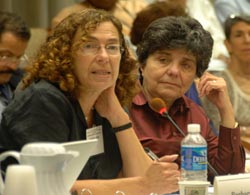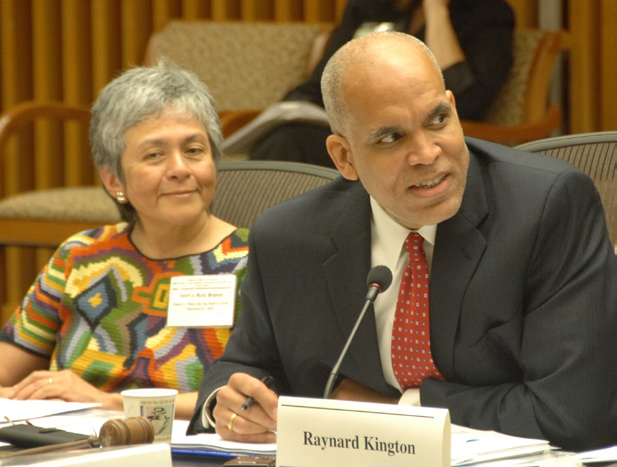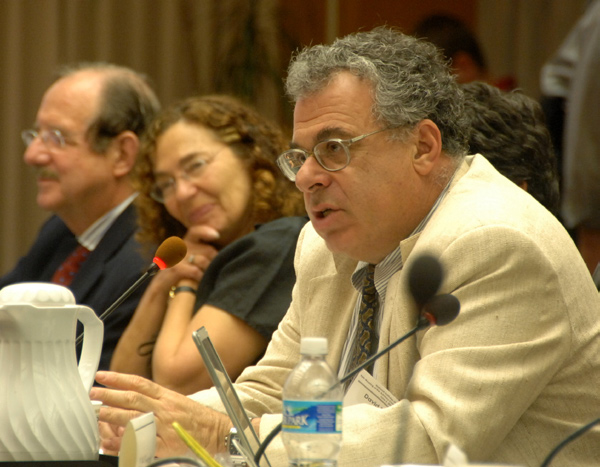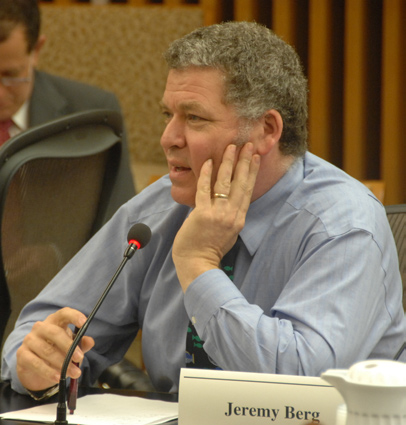| |
 |
|
|
|
|
| |
Dr. Barbara Wolfe (l) and Dr. Catherine DeAngelis at June 6 ACD meeting |
|
Review of Peer Review Produces Results
Zerhouni wants to make peer review better for both potential grantees and would-be reviewers.
Announcing the quest at about this time last year, he appointed two ACD work groups to ensure that NIH funds “the best science by the best scientists, with the least amount of administrative
burden.” One group, led by NIDCR director Dr. Lawrence Tabak and NIGMS director
Dr. Jeremy Berg, reported an 18-month enrichment plan.
Tabak identified four main priorities: Engage the best reviewers; improve quality of reviews; ensure balanced and fair reviews across fields and career stages and reduce burden on applicants;
and develop a permanent way to review peer review.
Zerhouni had urged a no-holds-barred approach to the issue, instructing the groups to consider all aspects of peer review and possible
ways to improve it. Tabak said the new initiatives were based on a few givens: “We view first-rate peer review as being a cornerstone
of what NIH does, but our reality is that the increasing breadth and complexity of science
have created some new challenges. Of course this has been exacerbated by the overlay
of funding trends.”
Key improvements include spreading the 12-session reviewer commitment over 4 to 6 years, evaluating new forms of high-bandwidth
electronic review and rewarding outstanding
and sustained review service. NIH will also redesign grant applications to stress impact, determine a minimum number of new-to-NIH and early-stage investigators to support, create a new Roadmap-funded Transformative
R01 with a minimum commitment of $250 million over 5 years and reduce the multiple-round resubmission burden for highly
graded applications.
“Essential to what we’ve tried to do is listen,” Tabak concluded, referring to the year-long period of feedback from hundreds of interested groups and individuals who vetted the current system as well as the draft enhancements. “We listened to the extramural community and to our staff here at NIH.”
Eyeing the NEIDL
The National Emerging Infectious Diseases
Laboratories (NEIDL, pronounced “needle”),
a biocontainment facility NIH is funding through a Boston University Medical Center
grant, is currently under construction in South Boston. NEIDL, slated to house much-needed biodefense and public health infectious
disease research, has been the target of criticism by Boston residents who do not want the facility built in their neighborhood. Of concern are public health and safety issues regarding the high-containment pathogens that would be studied at the NEIDL, which is designed to work as a biosafety-level-2 to biosafety-
level-4 facility.
 |
 |
Top, l:
NIH deputy director Dr. Raynard Kington presides over the recent ACD meeting. Also shown is NIH deputy director for extramural research Dr. Norka Ruiz Bravo.
Top, r:
ACD member Dr. David Botstein (r) of Princeton University comments during a discussion period. |
In March, Zerhouni assigned a 16-member blue-ribbon panel to investigate the facility’s
scope and related communication issues. More than 900 written comments on this topic have been reviewed by the panel. “Especially
robust” feedback was received at a public
meeting the panel held recently in Boston. Dr. Adel Mahmoud, a Princeton University professor and panel chair, said the group recommends
further studies be conducted to address concerns; that a range of agents be studied and that comprehensive analyses be conducted on possible “highly unlikely but still high-consequence event” scenarios.
“We still have much work to do,” he said.
Business as Usual
 |
| NIGMS director Dr. Jeremy Berg responds to questions
and comments about the NIH plan to enhance peer review. Berg and NIDCR director Dr. Lawrence Tabak led internal NIH efforts to make the system more attractive and more efficient both for grant applicants and reviewers. |
As is customary, ACD members also were briefed on several issues facing NIH since December, when the committee last convened. In particular, money mattered.
NIH’s FY 2008 budget—net $29.457 billion—was confirmed on Dec. 26 with the signing of the Consolidated Appropriations Act. The law “contained an across-the-board reduction of about 1.7 percent at NIH,” Kington reported, and provided 1-percent inflationary cost policies for both competing research project grants and non-competing RPGs. A supplemental bill for $400 million more this fiscal year was passed by the Senate on May 22, and has been sent to the House of Representatives for action.
The FY 2009 NIH budget request from the President
is identical to the 2008 budget, except there are no provisions for inflation.
Referring to testimony he gave on Capitol Hill Mar. 5, Zerhouni said, “Congress wants to identify
what it is specifically that we are losing...The point I made was the impact we see—especially
on early stage investigators—and the potential loss of both talent and competiveness over time.”
Keeping it Real
ACD member Dr. John Nelson of Globus Relief, who serves as liaison to the Council of Public Representatives (COPR), suggested that ACD and COPR members offer stories to the NIH director about the harmful effect reduced funding is having on the future scientific
workforce. Zerhouni could then incorporate these real-life illustrations in his next appearance before Congress.
“It’s very, very difficult to know where the next breakthrough will be,” Nelson said, “and we need to make that point strongly so the funding will continue.”
“It’s not so hard to demonstrate,” Zerhouni replied. “If you look at the total dollars
in clinical research, it’s dropped from a steady state of about $9 billion to $8.4 or $8.5 [billion]. Actually most of the reduction in the budget has been borne by clinical trials, large projects.
“We’ve been really focused on maintaining the ability of investigator-initiated
research to get funded,” he explained. “So last year in 2007—because there was a drop in the number of new investigators in 2006—we established a policy
that there would be no less than 1,523 [new investigators]. That’s about 25 percent of new grants. We were successful. In ’07, we achieved 1,596.”
The policy is still in place for 2008, he noted, but it comes at a price. “The cost is that you have to shift dollars from immediate clinical trials that are very expensive
to the support of these very vulnerable classes of scientists. We’ve been very good at showing the trade-offs that we have to make. There have been about a hundred trials that we’ve just had to stop or delay…I agree that we have to personalize
[the sacrifices] more to show what they mean in terms of real labs and individuals. The big areas [of lost opportunity] are vulnerable investigators, high-risk high-impact research and clinical trials.” 